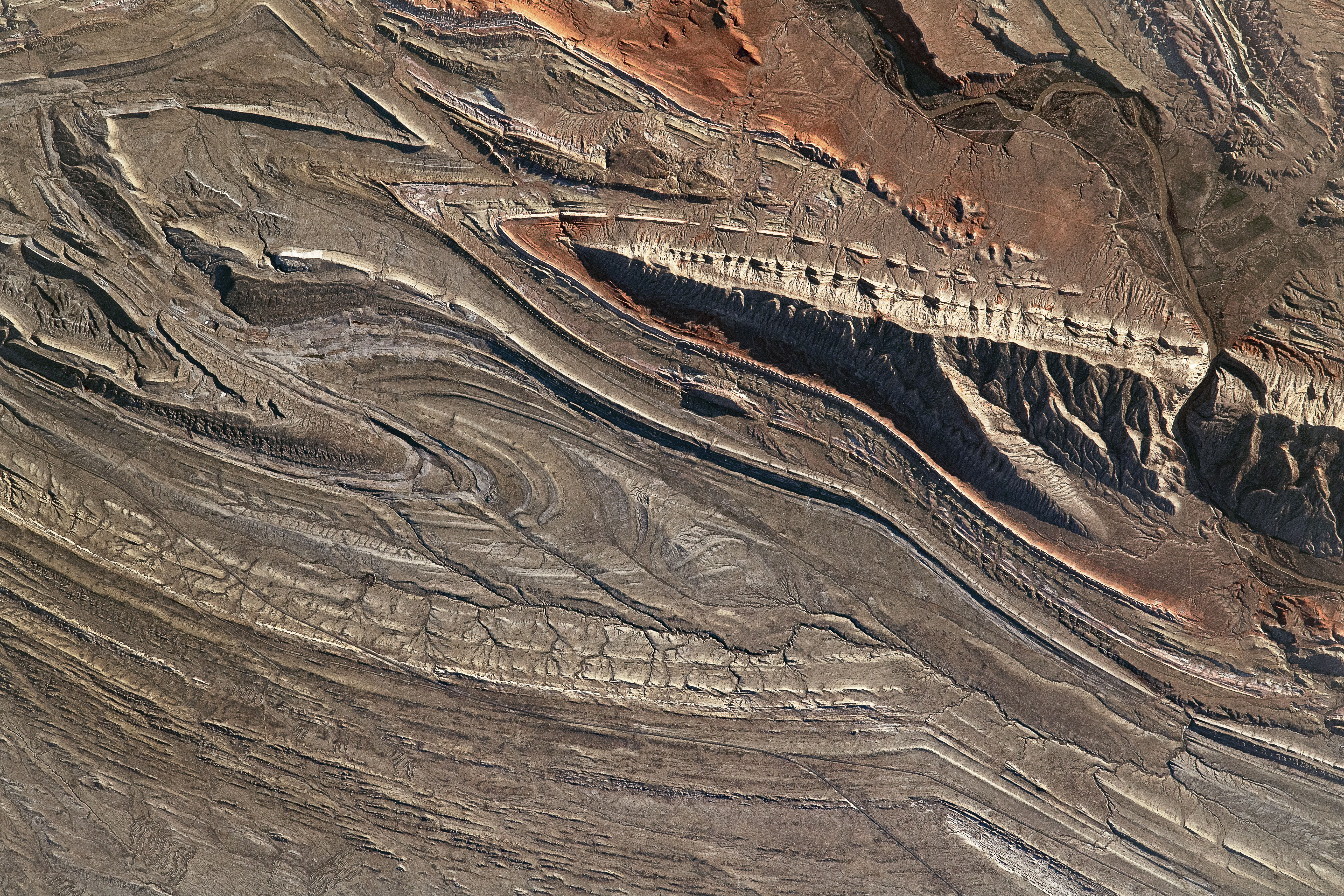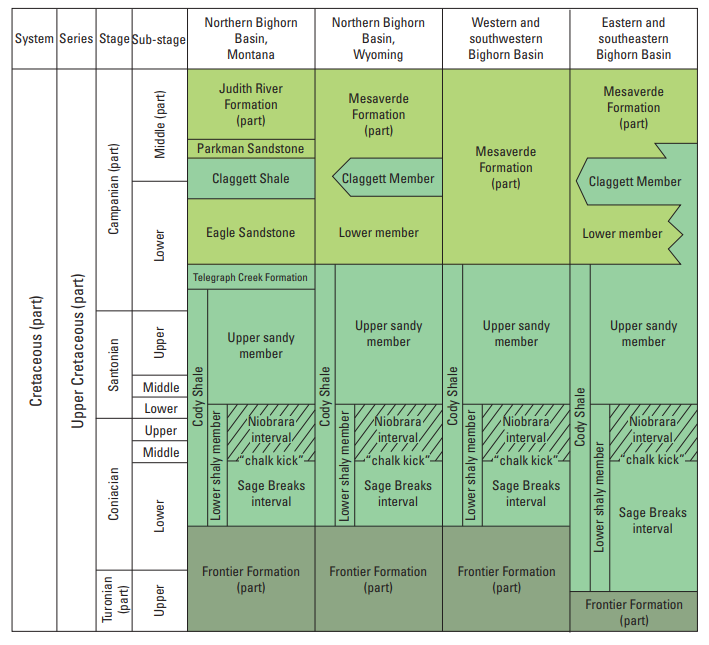Bighorn Basin on:
[Wikipedia]
[Google]
[Amazon]


 The Bighorn Basin is a
The Bighorn Basin is a


 The Bighorn Basin forms a geologic
The Bighorn Basin forms a geologic


 The Bighorn Basin is a
The Bighorn Basin is a plateau
In geology and physical geography, a plateau (; ; : plateaus or plateaux), also called a high plain or a tableland, is an area of a highland consisting of flat terrain that is raised sharply above the surrounding area on at least one side. ...
region and intermontane
Intermontane is a physiographic adjective formed from the prefix " inter-" (''signifying among, between, amid, during, within, mutual, reciprocal'') and the adjective "montane" (inhabiting, or growing in mountainous regions, especially cool, mo ...
basin, approximately 100 miles (160 km) wide, in north-central Wyoming
Wyoming ( ) is a landlocked U.S. state, state in the Mountain states, Mountain West subregion of the Western United States, Western United States. It borders Montana to the north and northwest, South Dakota and Nebraska to the east, Idaho t ...
in the United States
The United States of America (USA), also known as the United States (U.S.) or America, is a country primarily located in North America. It is a federal republic of 50 U.S. state, states and a federal capital district, Washington, D.C. The 48 ...
. It is bounded by the Absaroka Range on the west, the Pryor Mountains on the north, the Bighorn Mountains
The Bighorn Mountains ( or ) are a mountain range in northern Wyoming and southern Montana in the United States, forming a northwest-trending spur from the Rocky Mountains extending approximately northward on the Great Plains. They are separa ...
on the east, and the Owl Creek Mountains
The Owl Creek Mountains are a subrange of the Rocky Mountains in central Wyoming in the United States, running east to west to form a bridge between the Absaroka Range to the northwest and the Bridger Mountains to the east. The range forms the bo ...
and Bridger Mountains on the south. It is drained to the north by tributaries of the Bighorn River, which enters the basin from the south, through a gap between the Owl Creek and Bridger Mountains, as the Wind River, and becomes the Bighorn as it enters the basin. The region is semi-arid, receiving only 6–10 in (15–25 cm) of rain annually.
The largest cities in the basin include the Wyoming towns of Cody, Thermopolis, Worland, and Powell. Sugar beet
A sugar beet is a plant whose root contains a high concentration of sucrose and that is grown commercially for sugar production. In plant breeding, it is known as the Altissima cultivar group of the common beet (''Beta vulgaris''). Together with ...
s, pinto beans, sunflowers, barley, oats, corn and alfalfa hay are grown on irrigated farms in the region.
History
The basin was explored byJohn Colter
John Colter (c.1770–1775 – May 7, 1812 or November 22, 1813) was a member of the Lewis and Clark Expedition (1804–1806). Though party to one of the more famous expeditions in history, Colter is best remembered for explorations he made ...
in 1807. Just west of Cody, he discovered geothermal features that were later popularly called " Colter's Hell". The region was later transversed by the Bridger Trail, which was blazed in 1864 by Jim Bridger
James Felix Bridger (March 17, 1804 – July 17, 1881) was an American mountain man, Animal trapping, trapper, Army scout, and wilderness guide who explored and trapped in the Western United States in the first half of the 19th century. He was ...
to connect the Oregon Trail
The Oregon Trail was a east–west, large-wheeled wagon route and Westward Expansion Trails, emigrant trail in North America that connected the Missouri River to valleys in Oregon Territory. The eastern part of the Oregon Trail crossed what ...
to the south with Montana
Montana ( ) is a landlocked U.S. state, state in the Mountain states, Mountain West subregion of the Western United States. It is bordered by Idaho to the west, North Dakota to the east, South Dakota to the southeast, Wyoming to the south, an ...
. The route was an important alternative to the Bozeman Trail
The Bozeman Trail was an overland route in the Western United States, connecting the gold rush territory of southern Montana to the Oregon Trail in eastern Wyoming. Its important period was from 1863 to 1868. While the major part of the route us ...
, which had crossed the Powder River Country
The Powder River Country is the Powder River Basin area of the Great Plains in northeastern Wyoming, United States. The area is loosely defined as that between the Bighorn Mountains and the Black Hills, in the upper drainage areas of the Powde ...
, but had been closed to white settlers following Red Cloud's War
Red Cloud's War (also referred to as the Bozeman War or the Powder River War) was an armed conflict between an alliance of the Lakota people, Lakota, Cheyenne, Northern Cheyenne, and Northern Arapaho peoples against the United States and the Crow ...
. Around the turn of the 20th century the Bighorn Basin was settled by ranchers such as William "Buffalo Bill" Cody who founded the town of Cody and owned a great deal of land surrounding the Shoshone River. The Chicago, Burlington and Quincy Railroad
The Chicago, Burlington and Quincy Railroad was a railroad that operated in the Midwest, Midwestern United States. Commonly referred to as the Burlington Route, the Burlington, CB&Q, or as the Q, it operated extensive trackage in the states of ...
extended a branch line to Cody in 1901 and ultimately built through the entire basin. In 1904, Cody helped to form the Shoshone project, the nation's first federal water development project to help irrigate the western portion of the basin. The project culminated in the construction of the Buffalo Bill Dam and reservoir. The wealth in the region also attracted outlaws. Butch Cassidy
Robert LeRoy Parker (April 13, 1866 – November 7, 1908), better known as Butch Cassidy, was an American train robbery, train and bank robbery, bank robber and the leader of a gang of criminal outlaws known as the "Butch Cassidy's Wild Bunch, ...
lived near Meeteetse for a while and was arrested at the insistence of local cattle baron Otto Franc and sent to the Wyoming State Penitentiary for horse theft. Following his release, he formed the Wild Bunch
The Wild Bunch, also known as the Doolin–Dalton Gang, or the Oklahombres, were a gang of American outlaws based in the Indian Territory in the late 19th and early 20th centuries. They were active in Kansas, Missouri, Arkansas, and Oklahoma Terr ...
gang which operated from the Hole-in-the-Wall
Hole-in-the-Wall is a remote pass in the Big Horn Mountains of Johnson County, Wyoming. In the late 19th and the early 20th centuries, the Hole-in-the-Wall Gang and Butch Cassidy's Wild Bunch gang met at the log cabin, which is now preserved ...
area southeast of the Bighorn Basin.
In 1942 one of the nation's ten Japanese American
are Americans of Japanese ancestry. Japanese Americans were among the three largest Asian Americans, Asian American ethnic communities during the 20th century; but, according to the 2000 United States census, 2000 census, they have declined in ...
internment camps was located in Park County in the western part of the basin. The camp was named Heart Mountain Relocation Center
The Heart Mountain War Relocation Center, named after nearby Heart Mountain (Wyoming), Heart Mountain and located midway between the northwest Wyoming towns of Cody, Wyoming, Cody and Powell, Wyoming, Powell, was one of ten concentration camps ...
, after nearby Heart Mountain. The camp operated until 1945, and at its peak detained over 10,000 internees.
Geology


 The Bighorn Basin forms a geologic
The Bighorn Basin forms a geologic structural basin
A structural basin is a large-scale structural geology, structural formation of rock stratum, strata formed by tectonics, tectonic warping (Fold (geology), folding) of previously flat-lying strata into a syncline fold. They are geological dep ...
filled with more than of sedimentary rocks from Cambrian
The Cambrian ( ) is the first geological period of the Paleozoic Era, and the Phanerozoic Eon. The Cambrian lasted 51.95 million years from the end of the preceding Ediacaran period 538.8 Ma (million years ago) to the beginning of the Ordov ...
to Miocene
The Miocene ( ) is the first epoch (geology), geological epoch of the Neogene Period and extends from about (Ma). The Miocene was named by Scottish geologist Charles Lyell; the name comes from the Greek words (', "less") and (', "new") and mea ...
in age. Since the early 20th century the basin has been a significant source of petroleum, and has produced more than of oil. The principal reservoir of oil is the Pennsylvanian Tensleep Formation; Other important petroleum horizons are the Mississippian Madison Limestone, Permian Phosphoria Formation and the Cretaceous
The Cretaceous ( ) is a geological period that lasted from about 143.1 to 66 mya (unit), million years ago (Mya). It is the third and final period of the Mesozoic Era (geology), Era, as well as the longest. At around 77.1 million years, it is the ...
Frontier Sandstone.
Some uranium
Uranium is a chemical element; it has chemical symbol, symbol U and atomic number 92. It is a silvery-grey metal in the actinide series of the periodic table. A uranium atom has 92 protons and 92 electrons, of which 6 are valence electrons. Ura ...
has been mined in the northern part of the basin, along the Bighorn Mountains
The Bighorn Mountains ( or ) are a mountain range in northern Wyoming and southern Montana in the United States, forming a northwest-trending spur from the Rocky Mountains extending approximately northward on the Great Plains. They are separa ...
.
The eastern section of the basin is famously rich in fossils
A fossil (from Classical Latin , ) is any preserved remains, impression, or trace of any once-living thing from a past geological age. Examples include bones, shells, exoskeletons, stone imprints of animals or microbes, objects preserved ...
, with formations such as the Cretaceous period Cloverly Formation yielding numerous dinosaur fossils.
The alluvial strata of the Willwood and Fort Union Formations of the Bighorn Basin contain a well-documented record of the Paleocene-Eocene Thermal Maximum (PETM). Analysis of paleosol
In Earth science, geoscience, paleosol (''palaeosol'' in Great Britain and Australia) is an ancient soil that formed in the past. The definition of the term in geology and paleontology is slightly different from its use in soil science.
In geo ...
s here shows that the Bighorn Basin became more arid during the PETM, with wet/dry cycles superimposed over this general increase in aridity. These changes in environment are coupled with changes in paleoecology.
Communities
Notable Features
* Red Gulch Dinosaur Tracksite * Bighorn Canyon National Recreation AreaSee also
* Uranium mining in Wyoming *Wind River Basin
The Wind River Basin is a semi-arid intermontane foreland basin in central Wyoming, United States. It is bounded by Laramide orogeny, Laramide uplifts on all sides. On the west is the Wind River Range and on the North are the Absaroka Range and t ...
* Wyoming Basin shrub steppe
* Bighorn Basin Dinosaur Project
References
{{Authority control Plateaus of the United States Geology of Wyoming Sedimentary basins of North America Landforms of Big Horn County, Wyoming Landforms of Park County, Wyoming Landforms of Hot Springs County, Wyoming Landforms of Washakie County, Wyoming